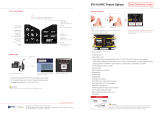Page is loading ...

Application Note February 2, 2015
Reducing Losses in Fusion Splicing
Core vs Cladding
Core alignment fusion splicer’s will have much better splice losses than cladding
alignment splicer’s because of the active alignment of the two fiber cores. This is
accomplished in the Greenlee Communications 910FS with two cameras and the
ability of the splicer to align the core of the fibers in the X, Y and Z domains. A full
analysis is given in the application note Core vs Cladding Alignment Fusion Splicer.
Fusion Splicing Losses
The splice loss displayed on the 910FS screen after splicing is only an approximation
and should be validated with an optical time domain reflectometer (OTDR) or optical
loss test set (OLTS). The determining factors for the displayed loss are cleave quality,
cleave axis and an analysis of the shape of the finished splice.
Fusion splicer’s quote the typical loss of singlemode splice to be 0.02dB. This is always
a cut and then re-splice of the same fiber. In the real world the technician will have to
splice different types of singlemode fibers together. Sometimes the fibers are old and
have different geometries when compared to newer fibers. Different manufacturer’s
fibers can also have different geometries. Usually a core alignment splicer can
accommodate these differences for single mode fibers but multimode fibers may
require some of the splicer settings to be fine tuned from the standard splicing profiles.
Older fibers have poor concentricity, varying core diameters and are made of different
formulations of glass with different dopants. Graded index multimode fibers are prone
to differences in geometries and are especially problematic. The typical multimode
splicing problems are due to core diameter, numerical aperture and index of refraction
mismatches. Fiber concentricity variations between the core and the cladding will
compound splicing difficulty.
If the 910FS has trouble splicing due to fiber mismatch and concentricity issues, the
manual modes of splicing must be used. The manual modes allow the technician to
change the arc power, arc duration and splice position with respect to the electrodes.
If one fiber is harder to melt than the other fiber the gap position can be changed
so that more energy is applied to the harder to melt fiber and less energy to the
softer fiber. The gap setting can also be increased or decreased so that the
splice can be made faster by adjusting the arc power and or arc duration.
Arc power and duration allow the technician to apply varying amounts of power
to the splice point. This may be necessary if the fibers are harder to melt and
require more heat to melt the fibers. The arc power and duration can also be
reduced to better control fiber melting.
This is very much a trial and error process and requires careful experimentation by the
technician. Consulting data sheets of the two fibers will simplify the process.

Core Mismatch Losses
Loss will be higher for signals travelling left to right.
Return loss will be high especially for signals travelling left to right.
Concentricity Losses
Especially problematic with cladding splicer’s.
Return loss will be high especially for signals travelling left to right.
Adjust Gap Setting and Position
Fiber #1 melts easier so more energy is applied to Fiber #2.
CORE 1
CORE 2
CORE 1
CORE 2
Fiber 1
Fiber 2
Electrodes
Gap Position
Gap Distance

A core diameter mismatch of 5 microns can cause a 0.2dB loss.
Notes
Always clean the fiber with 99% isopropyl alcohol and a clean lint free wipe prior
to cleaving.
If the cleaver does not cleave the fiber make sure that the acrylic coating was
removed.
Make sure that the technician performs an ARC calibration at the beginning of a
splicing session.
Do not touch the electrodes with your hand.
Stabilizing the electrodes may be necessary if the technician is experiencing
poor splicing performance.
/





